 Technology
Technology  Technology
Technology  Humans
Humans 10 Everyday Human Behaviors That Are Actually Survival Instincts
 Animals
Animals 10 Animals That Humiliated and Harmed Historical Leaders
 History
History 10 Most Influential Protests in Modern History
 Creepy
Creepy 10 More Representations of Death from Myth, Legend, and Folktale
 Technology
Technology 10 Scientific Breakthroughs of 2025 That’ll Change Everything
 Our World
Our World 10 Ways Icelandic Culture Makes Other Countries Look Boring
 Misconceptions
Misconceptions 10 Common Misconceptions About the Victorian Era
 Mysteries
Mysteries 10 Strange Unexplained Mysteries of 2025
 Miscellaneous
Miscellaneous 10 of History’s Most Bell-Ringing Finishing Moves
 Technology
Technology Top 10 Everyday Tech Buzzwords That Hide a Darker Past
 Humans
Humans 10 Everyday Human Behaviors That Are Actually Survival Instincts
 Animals
Animals 10 Animals That Humiliated and Harmed Historical Leaders
Who's Behind Listverse?

Jamie Frater
Head Editor
Jamie founded Listverse due to an insatiable desire to share fascinating, obscure, and bizarre facts. He has been a guest speaker on numerous national radio and television stations and is a five time published author.
More About Us History
History 10 Most Influential Protests in Modern History
 Creepy
Creepy 10 More Representations of Death from Myth, Legend, and Folktale
 Technology
Technology 10 Scientific Breakthroughs of 2025 That’ll Change Everything
 Our World
Our World 10 Ways Icelandic Culture Makes Other Countries Look Boring
 Misconceptions
Misconceptions 10 Common Misconceptions About the Victorian Era
 Mysteries
Mysteries 10 Strange Unexplained Mysteries of 2025
 Miscellaneous
Miscellaneous 10 of History’s Most Bell-Ringing Finishing Moves
Top 10 Fascinating Alternatives To Plastic
Why must we transition from plastic-based materials to biodegradable alternatives?
Beyond noticeable everyday plastic pollution, the methods of extracting the petroleum and natural gas required to produce plastic often devastate the surrounding environment. The toxic chemicals contained in plastic also leach into foods, beverages, oceans, and groundwater.
Most shockingly, recycling merely slows down the journey of plastics to landfills where the material fragments into smaller and smaller pieces of plastic rather than biodegrading. Alas, scientists, engineers, and environmentally conscious individuals are shifting their focus to ecologically friendly alternatives that can biodegrade and add nutrients to the soil.
Could these unusual alternatives to plastic propel us toward a cleaner, greener future?
10 Fungus
Imagine if you could grow your own surfboard, urn, or furniture.
Fungus is invading the ecodesign industry, replacing materials like Styrofoam, protective packaging, insulation, acoustics, core materials, and even aquatic products. (Wax up the mushroom surfboards!)
By simply culturing fungi in different ways, a vast array of materials like rubber, leather, cork, and plastic can “germinate” like a plant sprouting from a seed. This is because fungi consists of many different filaments which grow from a core.[1]
At some point, those filaments start branching out to create a network. When fungus grows with wood pulp, for example, it decomposes the wood while simultaneously gluing the pulp together. The result is a composite which is held together naturally.
If the thought of a fungi chair growing in your living room sounds slightly grotesque, fear no more. Mycelial products are rendered inert before the point of distribution. By baking at precise temperatures, the microorganisms are inactivated while the mass and new structure itself is solidified.
The end result? A material that is light, strong, fire-resistant, water-repellent, and fully compostable—breaking down within 180 days.
9 Algae
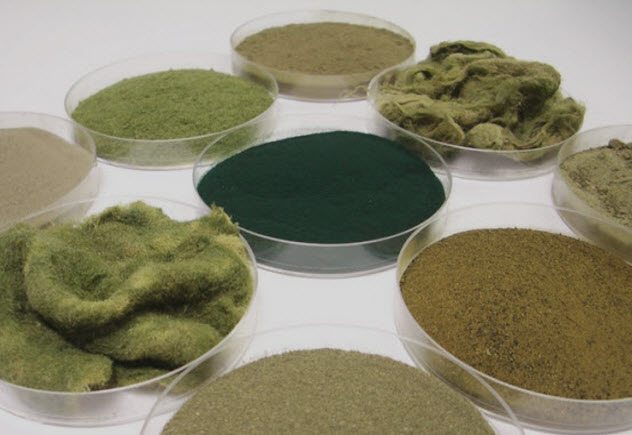
Sustained by four simple ingredients—carbon dioxide, sunlight, water, and inorganic nutrients—algae are very reasonable in their dietary needs. What else is there to love about algae?
Serving as bioremediators, algae have the incredible ability to consume waterborne contaminants while quickly yielding clean water. Through the process of photosynthesis, algae also capture carbon dioxide and produce fresh, clean oxygen. A bioplastic producer called Solaplast reveals that each pound of algae collected for production consumes approximately two pounds of carbon dioxide.
The process of creating this type of bioplastic requires breaking down harvested algae into tiny granules. Companies can then produce 100 percent algae-based plastics or a mixture of algae and petroleum. These granules become a key ingredient in a variety of consumer products such as USB drives, toys, eyeglass frames, key chains, road signs, food packaging, and lamps.
So, what’s the future for these mighty little beings?
According to researchers, the hunt is on for a new species of algae which produces the right kind of hydrocarbons and sugars.[2] Could genetic engineering yield such organisms and thrust humanity into a new era of consumer products completely free of fossil fuels?
8 Potato Starch
Did you know that the starchy residue left over in the production of potato chips and french fries could be an eco-friendly ingredient in the composition of your bioplastic bag?
A company called BioLogiQ is successfully combining potato starches with polyurethane to produce plastic bags that are much stronger and thinner than entirely polyurethane-made bags.
The outcome? A potato-based plastic that requires less polyurethane than traditional bags and reduces the use of oil-based materials. Sounds like a step in the right direction.[3]
No longer a spectator to the promising advantages of starch-based products, the pharmaceutical industry is now widely incorporating potato starch in the production of medicinal capsules. In fact, making potato starch bioplastic is so easy that you can follow the process at home with common household ingredients.
7 Millets, Rice, Wheat
Edible Cutlery
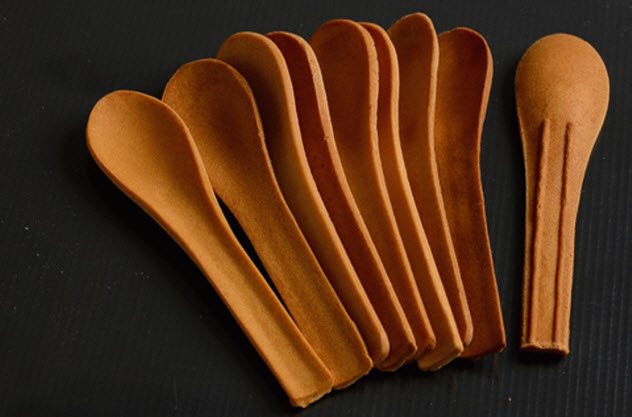
Imagine if you could eat your cutlery right alongside your meal. Bakeys Edible Cutlery, the future of eco-friendly utensils, has figured out the perfect combination of simple grains (and a touch of salt) to produce a nutritious alternative to landfill-bound plastic disposables.
Without using added fat or emulsifiers, the recipe is so simple that the shelf life of these crispy, moisture-free utensils averages three years (if you can resist eating them). The main ingredient in Bakeys cutlery is a hearty and abundant crop that requires little energy for cultivation—sorghum flour.
A Bakeys representative said, “Of the energy it takes to produce one plastic utensil, we can produce 100 sorghum-based spoons.”[4] Additionally, an increased demand for sorghum may motivate farmers to focus their energy on growing millet over rice, requiring 60 times less water to propagate.
Keep an eye out for this totally vegan alternative to plastic on the market. Bakeys will soon be releasing edible chopsticks, dessert spoons, forks, cups, and plates in three flavors. The only decision will be: plain, sweet, or spicy?
6 Banana Tree
A resourceful new technique for ecoplastic production is blossoming from a surprising locale—the banana plantations of the Canary Islands and Uganda.
The banana fruit is harvested, but the remainder of the plant typically goes to waste. An estimated 25,000 tons of this natural fiber is dumped in ravines around the Canaries every year. An eco-blunder with a promising future!
The natural fibers of the banana tree are incredibly durable and useful in the production of rotationally molded plastics—a technique used to make everyday items such as water tanks, wheelie bins, traffic cones, and even boats.[5]
Once processed, treated, and added to a mixture of plastic material, the banana plant fibers can be incorporated to strengthen plastics and reduce the amount of polyurethane used by a substantial degree. What’s more, opportunities for research and development are already creating jobs and increasing profits for banana tree growers.
5 Leaf
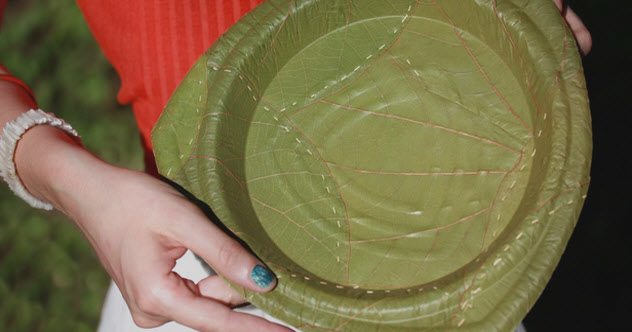
Still in its Kickstarter phase, Leaf Republic has conceived of a method that turns fallen leaves into tableware. Their vision? No chemicals, no plastic, and not a single tree cut down. In fact, these plastic replacements are as renewable and biodegradable as the vines from which they fall.[6]
The leaves are sourced from local villagers in Asia and South America. They sustainably collect the leaves from species of the “wild creeper.”
Designed for durability and multiple uses, three layers of leaves are stitched together with palm fibers. The product is a naturally elegant work of art—you won’t want to leaf them at home!
4 Corn
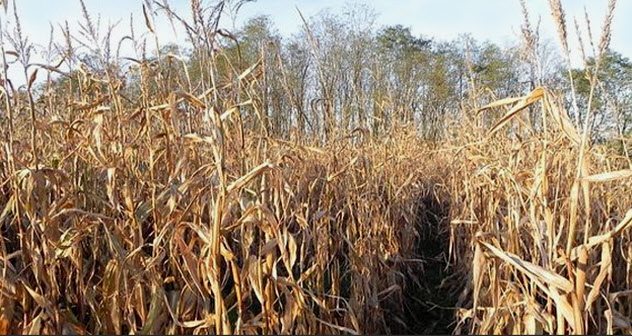
Polylactic acid (PLA) is a substitute for plastic that is made from fermented cornstarch. It has already hit the bio-based plastic market, albeit with its fair share of issues. Have you ever found yourself confused about how to dispose of takeout containers with PLA labels?
As they look almost identical to common plastic recyclables, PLA containers often end up in the recycling stream rather than the compost bin. This slows down the entire waste management process.
Though certified PLA is expected to biodegrade, the process is painstakingly slow under typical landfill conditions. For example, a PLA bottle is estimated to take anywhere from 100 to 1,000 years to decompose in a landfill.
Furthermore, PLA is typically made from genetically modified corn—a process in which the environmental and social effects are unknown and potentially harmful.
Any redeeming qualities?
Though many steps need to be made in the proper use of PLA products, proponents observe its effectiveness as a renewable, carbon-absorbing, plant-based material. Also, when incinerated, PLA does not emit the toxic fumes characteristic of traditional petroleum-based products.[7]
3 Cassava
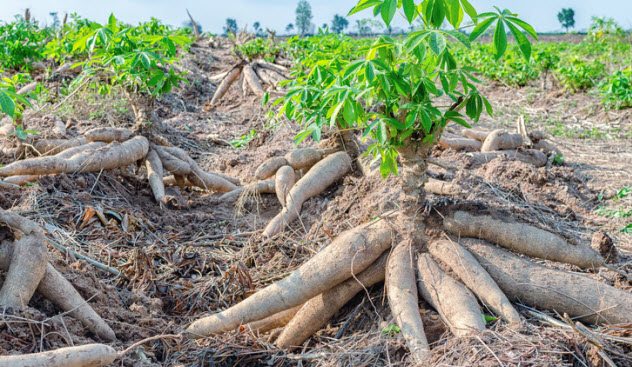
Cassava grows abundantly in Southeast Asia, but don’t underestimate this cheap and common root vegetable. A recipe combining vegetable oil, organic resins, and cassava starch promises a 100 percent biodegradable and compostable plastic alternative.[8]
Cassava-based plastic can instantly break down in hot water and takes only a few months to decompose on land or at sea while leaving no trace of toxic residue. The team producing cassava plastic bags at Avani Eco maintains that this bioplastic is so harmless to sea animals that a human can drink it after dissolving it in hot water.
Avani Eco now produces four tons of cassava-based material a day that is used for products including plastic bags, food packaging, and covers for hospital beds.
2 Shrimp Shells
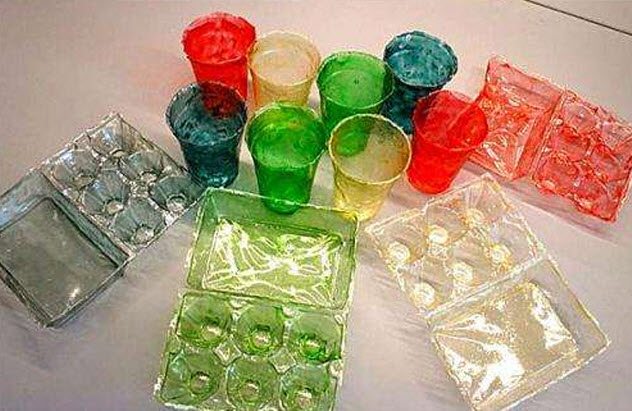
Could the overabundance of crustacean shell waste in Egypt be the answer to the search for an eco-friendly plastic?
The natural polymer derived from the hardy shells of shrimp is called chitosan, a form of chitin, and is the second most abundant material on Earth. The most available chitin comes from discarded shrimp shells, although this long-chain polysaccharide can also be found in other crustaceans, fungal cell walls, armor-like insect cuticles, and butterfly wings. In fact, just 1 kilogram (2 lb) of shells can yield 15 biodegradable bags.
To make the bioplastic, the collected shrimp shells are boiled in acid to remove their calcium carbonate. An alkaline substance is applied to produce the long molecular chain of which the biopolymer is comprised. The dried chitosan is then dissolved and developed into a polymer, plastic-like film using conventional processing techniques.[9]
The resulting polymer is biodegradable, has antibacterial properties, and makes use of otherwise wasted materials. Shrimp shell–derived polymers may be one of the more obscure bioplastic materials and just the type of creative thinking we need.
1 Hemp
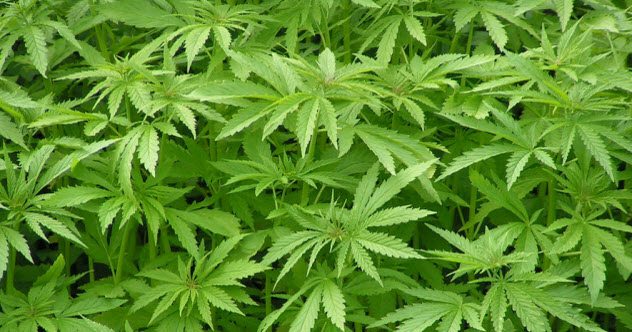
What makes hemp an ideal bioplastic material?
The natural fiber composite harvested from the Cannabis sativa L. stalks (aka hemp) is an affordable, biodegradable, recyclable, and toxin-free material. Applications range from cordage to automotive parts, Styrofoam, and even resilient building materials.
The Cannabis plant is not called “weed” for nothing. From seed to harvest, hemp plants take just three to four months to grow and have adapted to every continent except Antarctica. As hemp plants are amazing at absorbing carbon dioxide, they grow quickly and outpace competing plants. Hemp plants also require few pesticides, fertilizers, and water, providing a low-maintenance, high-yielding crop.[10]
With the technological advancement of 3-D printing, the future of hemp bioplastics looks promising. Companies such as Kanesis and Zeoform are using hemp cellulose as the feedstock for 3-D printers and are producing an almost unlimited product range.
Read more about plastics on 10 Ways Recycling Hurts the Environment and 10 Crazy Futuristic Predictions.








